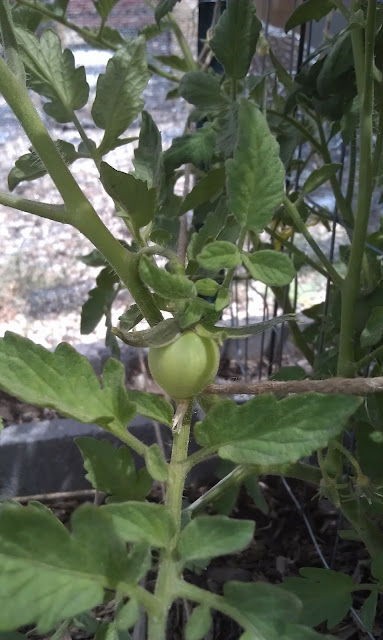Bees help to pollinate these kinds of plants by the vibrations they cause inside the flower with their buzzing. This vibration causes the pollen to fall from the anther (male part) onto the stigma (female part) within the single flower. Furthermore, when the bees fly from flower to flower they help to spread the pollen from multiple male parts of the flowers to several female parts throughout the plant.
You can accomplish this with hand-pollination in a few ways. One method is to gently 'flick' near the blossoms. A second method is to give each stalk a quick (yet not too rough) 'shaking'. Both of these methods will help to knock the pollen from one part of the flower to the other part, and possibly even to other flowers nearby. Watch the YouTube video below for a great visual on how to flick and shake tomatoes (and peppers) to pollinate them.
Prior to beginning to hand-pollinate my tomatoes I kept seeing new blossoms, then a few days later the blossom stem would dry up and fall off. I was concerned I had some kind of pest in my garden that was killing my blossoms. That was before my light-bulb-moment when I realized what was missing were the honey bees. Just a couple of days after beginning to hand-pollinate my tomato plants I discovered my first tomato! Then the next day I saw another!
 |
| My first tomato! Discovered just 2 days after I started hand-pollinating my tomatoes. |
 |
| My 2nd tomato discovered the next day. |
And I began to notice that some of my 'blossom stems' were thickening up, which they apparently do prior to the baby tomato developing so the stem is strong enough to hold the weight of the growing tomato. I know this now because I monitored one of the thickening blossom stems and watched it turn into a tiny tomato the next day. You can't see it very well in the picture below, but the blossom stem became thickened, then the next day the blossom began to dry up and out popped a tiny tomato behind it. No more tomato blossoms dropping off because of lack of pollination in my garden!
 |
| Tomato #3 in the works! |
The two hand-pollination methods mentioned above worked best for my tomatoes, but I found that it didn't work as well for my okra. Okra is also a self-pollinating plant but like all other plants, it needs the bees to help stir things up inside the blossoms. However, the okra blooms seemed to have a much smaller window of time to be pollinated. So I again used my grandkids little paint brush to 'paint' around inside each flower as soon as I noticed one. [See picture below]
Success! The day after, the blossoms closed and started to dry up and I could see little okra's growing. Where I was getting about 1 or 2 okra's each week, suddenly I now have about 5 of them growing at one time, and new okra blossoms are opening each day. So instead of 1 fruit on most of the plants, I now have multiple fruits on all of the plants! I am becoming quite the bee-surrogate.
You can see on the (slightly blurry) picture above that I have one growing okra, one blossom, and three tiny blossoms-to-be opening in the next day or two. This is all after just 3 days of hand-pollinating them. Prior to that I would maybe have one blossom that might have turned into an okra (but most just dried up and fell off), and no new babies until after I harvested that lone okra. It was pretty dismal, especially since okra is one of my most favorite veggies.
On a side note...Prior to beginning hand-pollination in my garden I realized that the scorching sun and steady temps well over 90 degrees every day for more than a month might be taking a toll on my plants. This is a problem for those of us who garden in Arizona. So I added this shade cover over most of my plants. I didn't worry too much about the zucchini plants on the far right end because they have such huge thick leaves that the delicate blossoms and fruit underneath are pretty well protected from the harsh sun. I can always extend the shade later if needed.
 |
| Finished putting up my garden shade just before sundown. |
Are you having problems with lack of bees where you live? What are you doing about it? Besides hand-pollinating your plants, visit this website to see how you can Help Save the "Bees Before its Too Late".
Keeper of 1 husband, 2 grandkids, 3 dogs,
3 cats, and 17 Chickens!
3 cats, and 17 Chickens!
Did this post stir something inside of you? If so, Please leave me a comment, I would love to know what you're thinking!!!



Great info and help thanks. I have been trying to polinate my okra with a brush but no success I'll try to catch the blooms earlier and push the brush in deeper on my okra now.
ReplyDelete